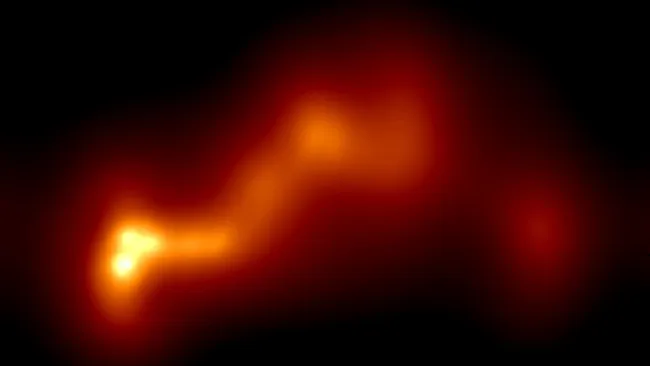A groundbreaking study has spotlighted the blazar OJ 287 as a likely host of the most extreme binary black hole system ever found. Recent radio observations have revealed a jet of particles blasting from the system’s primary black hole that is severely bent—strong evidence supporting the presence of a second, massive companion.
Located roughly four billion light-years from Earth, OJ 287 is a blazar—a type of quasar that’s observed nearly head-on, making it appear intensely bright. In such systems, material spirals into a supermassive black hole, forming an accretion disk. Enormous magnetic fields then launch twin relativistic jets in opposite directions.
However, OJ 287 stands apart. Astronomers have tracked its fluctuating brightness for 150 years. Its 12-year cycle is believed to result from a smaller black hole, 150 million times the Sun’s mass, orbiting the main black hole—estimated at 18.35 billion solar masses. Every orbit, the smaller black hole punctures the accretion disk of its giant counterpart, temporarily forming its own disk and jet, briefly turning OJ 287 into a double quasar.
This theory gained further support in 2021, when the system suddenly brightened within 12 hours, emitting more energy than 100 average galaxies combined—just as predicted.
Now, the clearest image yet of the system’s permanent jet has come from a collaboration between the Very Long Baseline Array (VLBA) and Russia’s RadioAstron satellite. The combined ground-space interferometer achieved a resolution five times Earth’s diameter, revealing a jet twisted in three places and angled variably by up to 30 degrees.
According to lead astronomer Efthalia Traianou of Heidelberg University, this distorted jet confirms that its shape is being influenced by the gravitational pull of the orbiting second black hole. The jet’s reorientation happens alarmingly close to the source, indicating extreme gravitational interactions.
The same observations also captured a shockwave and high-energy gamma ray burst—evidence of a newly formed jet component. Some jet regions seemingly reach 10 trillion degrees Celsius, though this is likely an illusion from relativistic beaming.
OJ 287’s binary nature makes it a critical subject in gravitational wave research. Although its supermassive black holes won’t merge soon, their gradual in-spiral emits faint gravitational waves. These waves are currently undetectable by ground-based detectors but might be picked up by pulsar timing arrays or the upcoming LISA mission, expected in the 2030s.
The full findings were published on July 30 in the journal Astronomy & Astrophysics, marking a milestone in our understanding of binary black hole systems, relativistic jets, and extreme gravitational dynamics.







